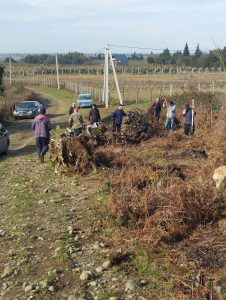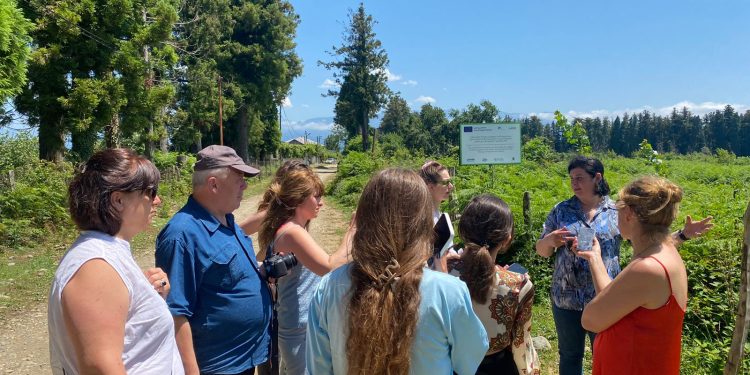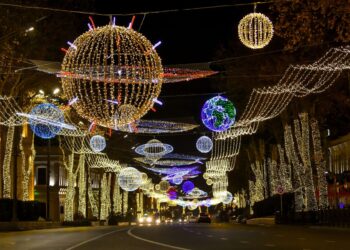In the heart of Laituri township, the Lotus Community Foundation is spearheading a transformative EU-supported initiative aimed at restoring a critical windbreak that has long been neglected. This project, which won the EU-funded small grants competition held within CENN’s Climate Action Project, involves the establishment of a 1.5 km windbreak, seeks to shield the community from destructive winds while promoting environmental sustainability. Lia Kotrikadze, a representative of the foundation, shares insights into this impactful endeavor.
A Focus on Restoration
“The township has been suffering from the consequences of an exposed environment,” Kotrikadze explains. “The existing wind barrier was damaged, leaving residents vulnerable to natural events like strong winds and hurricanes.” The decision to focus on restoring the windbreak stemmed from the pressing need to protect not just the land but also the livelihoods of the local population.
The initiative aims to reduce wind speed, protect soil from erosion, lessen crop losses, mitigate noise pollution, and safeguard residents from damage caused by extreme weather. “Our goal is to create a protective buffer that enhances the quality of life for everyone in Laituri,” she adds.
Education and Community Engagement
Central to the project is a comprehensive training program designed to educate local residents about the importance of windbreaks. “We wanted to show the population the critical role windbreaks play in maintaining soil health and agricultural productivity,” Kotrikadze emphasizes. This education initiative was essential in fostering understanding and appreciation among community members.
Workshops covered a range of topics, from the mechanics of how windbreaks work to their long-term benefits. “The locals understood that a windbreak is essential for their farms and their families,” she adds. This effort culminated in a series of awareness campaigns, including the distribution of informative calendars titled “Less Wind in Laituri.” “These materials helped solidify the community’s understanding and commitment to the project,” Kotrikadze notes.
Protecting the Windbreak
To ensure the longevity of the newly established windbreak, protective measures, including fencing, are essential. “The fence is crucial for protecting the saplings from damage and ensuring the success of the project,” she states. This fencing not only deters animals but also serves as a visual reminder of the community’s commitment to the initiative.
The local forest department has allocated a 1.5 km strip for this purpose, demonstrating a collaborative effort between the foundation and local authorities. “With their support, we can guarantee that the windbreak will receive the necessary care and attention it needs to thrive,” Kotrikadze affirms.
Community Involvement in Planting
The community played a vital role in the planting process, contributing to the planting of around 3,000 poplar tree seedlings. “Residents were actively involved in this volunteer activity, which was instrumental to the project’s success,” Kotrikadze shares. This collective effort not only facilitated the planting process but also fostered a spirit of collaboration and commitment among locals.
“The involvement of the community has been heartwarming,” she continues. “It shows how much they care about their environment and their future.” This sense of ownership is crucial for the project’s sustainability, as community members are more likely to take responsibility for protecting and maintaining the windbreak.

Environmental Benefits
The windbreak is expected to deliver numerous environmental advantages. “It will significantly improve soil fertility, protect against wind erosion, and reduce crop losses,” Kotrikadze explains. By acting as a barrier, the windbreak helps to slow down wind speeds, allowing for better moisture retention in the soil and benefiting adjacent agricultural fields.
“During the growing season, the windbreak will collect moisture and reduce evaporation, which is vital for crop health,” she adds. Additionally, in winter, the snow accumulation on the windbreak will help retain soil moisture, preventing drought conditions during the dry months. “This initiative not only protects the land but also supports the economic stability of our community,” Kotrikadze emphasizes.
Aligning with Broader Goals
This project aligns closely with broader climate resilience and sustainability goals in the Guria region. “We aim to promote not just environmental protection, but also economic development,” Kotrikadze states. The benefits of the windbreak extend beyond immediate protection; they contribute to a healthier ecosystem, enhancing biodiversity and regulating local climate conditions.
“By improving air quality and reducing noise pollution, we are creating a more livable environment for our residents,” she notes. This holistic approach underscores the project’s alignment with global sustainability goals, aiming to create a more resilient and prosperous community.
Challenges and Resolutions
While the project has seen significant progress, it has not been without challenges. “One of the biggest hurdles we faced was bad weather—rainy and windy conditions delayed our planting activities,” Kotrikadze admits. These delays could have jeopardized the project timeline, but through teamwork and adaptability, the foundation was able to navigate these obstacles.
“We learned to be flexible and adjust our plans accordingly,” she explains. By working closely with community members and local authorities, the foundation ensured that the project remained on track, demonstrating the resilience of both the initiative and its stakeholders.
The windbreak initiative in Laituri represents a vital step toward fostering community resilience and environmental sustainability. Through education, collaboration, and active community participation, the Lotus Community Foundation is not just restoring a physical barrier against the elements but also strengthening the bonds within the community. As Kotrikadze aptly puts it, “Together, we are creating a safer and more sustainable future for everyone in Laituri.”
This project shows the power of collective action in addressing environmental challenges, proving that when communities come together, they can cultivate both a greener landscape and a stronger sense of community. The restoration of the windbreak is not just about trees; it’s about building a legacy of resilience and stewardship for generations to come.
Since 2021, CENN has been implementing a four-year project, the Georgia Climate Action Program, with the financial support of the European Union. The project is being carried out in four target regions: Kakheti, Imereti, Guria, and Racha-Lechkhumi, and its aim is to increase civil society engagement in the development and implementation of climate change policies.
As part of the project, CENN announced the competition for the innovative ideas on climate change mitigation and adaptation. The Lotus Community is one of the winners, implementing a 9,000 EURO initiative for climate mitigaton.














